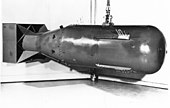
Back تأثيرات ناجمة عن انفجار القنبلة النووية Arabic Atom bombalarının dağıdıcı təsirləri Azerbaijani Efectes de les armes nuclears Catalan Нуклонсарла сирпĕнĕвĕн пĕтерекен факторĕсем CV Efectos de las armas nucleares Spanish Ydinräjähdyksen vaikutukset Finnish השפעות פיצוץ גרעיני HE नाभिकीय विस्फोट के परिणाम Hindi Dampak ledakan nuklir ID Effetti delle esplosioni nucleari Italian

| Nuclear weapons |
|---|
 |
| Background |
| Nuclear-armed states |
|
The effects of a nuclear explosion on its immediate vicinity are typically much more destructive and multifaceted than those caused by conventional explosives. In most cases, the energy released from a nuclear weapon detonated within the lower atmosphere can be approximately divided into four basic categories:[1]
- the blast and shock wave: 50% of total energy[2]
- thermal radiation: 35% of total energy
- ionizing radiation: 5% of total energy (more in a neutron bomb)
- residual radiation: 5–10% of total energy with the mass of the explosion.
Depending on the design of the weapon and the location in which it is detonated, the energy distributed to any one of these categories may be significantly higher or lower. The physical blast effect is created by the coupling of immense amounts of energy, spanning the electromagnetic spectrum, with the surroundings. The environment of the explosion (e.g. submarine, ground burst, air burst, or exo-atmospheric) determines how much energy is distributed to the blast and how much to radiation. In general, surrounding a bomb with denser media, such as water, absorbs more energy and creates more powerful shock waves while at the same time limiting the area of its effect. When a nuclear weapon is surrounded only by air, lethal blast and thermal effects proportionally scale much more rapidly than lethal radiation effects as explosive yield increases. This bubble is faster than the speed of sound.[3] The physical damage mechanisms of a nuclear weapon (blast and thermal radiation) are identical to those of conventional explosives, but the energy produced by a nuclear explosion is usually millions of times more powerful per unit mass, and temperatures may briefly reach the tens of millions of degrees.
Energy from a nuclear explosion is initially released in several forms of penetrating radiation. When there is surrounding material such as air, rock, or water, this radiation interacts with and rapidly heats the material to an equilibrium temperature (i.e. so that the matter is at the same temperature as the fuel powering the explosion). This causes vaporization of the surrounding material, resulting in its rapid expansion. Kinetic energy created by this expansion contributes to the formation of a shock wave which expands spherically from the center. Intense thermal radiation at the hypocenter forms a nuclear fireball which, if the explosion is low enough in altitude, is often associated with a mushroom cloud. In a high-altitude burst where the density of the atmosphere is low, more energy is released as ionizing gamma radiation and X-rays than as an atmosphere-displacing shockwave.
- ^ "Nuclear Explosions: Weapons, Improvised Nuclear Devices". U.S. Department of Health and Human Services. 16 February 2008. Retrieved 3 July 2008.
- ^ "Nuclear Radiation Protection Guide Civil Defense". www.atomicarchive.com. Retrieved 2022-04-10.
- ^ "Yield (kilotons)". Archived from the original on 2013-06-07. Retrieved 2012-04-27.